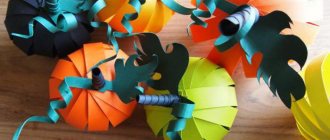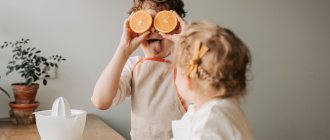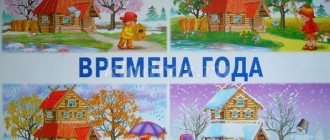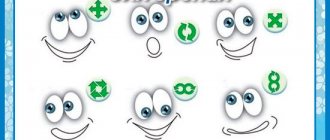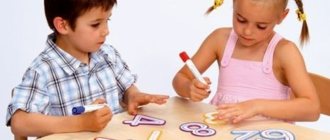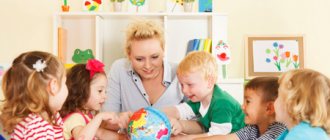The methodology for identifying the creative abilities of younger schoolchildren is based on educational activities. It not only reveals the knowledge and skills necessary for life in society. The main goal of the methodology is the development of personality and its self-realization, the creation of one’s own ideas and their implementation.
Creativity is understood as changing reality with the help of extraordinary, new, unique ideas. When assessing the level of such abilities, one should take into account the different degrees of development of children. A big role is played by: perception, imagination, resourcefulness, originality.
Diagnostics to identify creative abilities in primary schoolchildren
It is necessary to diagnose creative and mental abilities from an early age.
This reveals the child's development indicators. The range of abilities depends on physical health, perception of the surrounding world, upbringing and psycho-emotional state:
- minimal manifestation (lag);
- age-appropriate level (normal development);
- manifestation of a high level (anticipation).
The main goal of diagnostics is the timely identification of lagging and gifted children. This allows us to develop further activities aimed at the further development of schoolchildren.
Common diagnostic methods include testing:
- graphic;
- oral;
- situational.
To achieve the most effective result, the techniques are combined.
Memo for parents, or practical advice
Children may show an inclination towards several areas of activity at once. Or inclinations may not be very clearly expressed. If you have been watching your child for a long time, but are not entirely sure what abilities need to be developed, a simple test will help you determine the correct answer.
Read the following statements carefully and confirm or refute them:
- Excellent memory for poems and stories.
- The child senses your mood.
- The child asks educational questions, for example, who invented time.
- Excellent terrain orientation (even in an unfamiliar area).
- A ballerina would envy the baby’s gait.
- My favorite thing to do is listen to music.
- The circle of interests is the surrounding world: thunderstorms, lightning, rain, snow, etc.
- Perfect auditory memory: if you rearrange the words in your favorite book, he will definitely correct you.
- He quickly mastered tying shoelaces or riding a bicycle.
- You regularly become a spectator of a home theater with your favorite child in the leading role or a participant in creative evenings.
- During the trip, the child's attention is focused on the features of the area.
- Perfectly distinguishes the sound of musical instruments.
- It is much easier for a child to schematically depict an area than to explain it in words.
- Accompanying most words and movements with active facial expressions.
- All toys are in place from smallest to largest or sorted into cabinets according to color or size.
- He explains his actions by the feelings he experienced at that moment.
- Every day you listen to amazing stories that “happened” to your baby.
- Every sound heard is given a comment.
- In all strangers he looks for similarities with children or adults he knows.
- Surprises you with a clear assessment of your strengths and capabilities (for example, I can’t carry this bag, it’s too heavy).
Key to understanding
- If you confirmed statements 1, 8, 17, the child exhibits linguistic abilities.
- If you confirmed statements 6, 12, 18, the child’s musical abilities are evident.
- If you confirmed statements 3, 7, 15, your baby has mathematical abilities.
- If you confirmed statements 5, 9, 14, your baby has sensory abilities.
- If you confirmed statements 10, 16, 20, your baby has a tendency towards self-knowledge.
- If you confirmed statements 2, 10, 19, the basis for development is psychological abilities.
- If you confirmed statements 4, 11, 13, topographical (spatial) abilities are clearly expressed.
Now you are fully armed, because you know exactly what abilities a child needs to develop so that in the future he will reach incredible heights. Your child's success is in your hands. The main thing is not to give in to temptation and not to instill in your child qualities he does not need. By developing your natural inclinations, you will achieve maximum success in its development.
Methods and techniques of study
The use of effective methods for studying creative abilities is structured as follows.
- Primary diagnosis.
A written survey of parents and children is conducted. Supervision of children at school and at home is organized.
- Carrying out special diagnostics.
At the second stage, tests are carried out, questionnaires are filled out, and creative tasks are completed.
To determine a child’s ability to be creative, adults are asked to answer a list of questions: parents and teachers. For this, it is good to use the “Giftedness Map”. This test was developed according to the method of Haan and Cuff. The questionnaire can include up to 80 questions. Time to answer: 15 minutes. After processing the results, the degree of giftedness of the child is revealed. A convenient systematization of the results shows what type of abilities the child is currently developing. The ten scores obtained constitute an “individual portrait” of abilities. Based on the results obtained, a personal development program can be drawn up.
The second most popular method is the “Palette of Interests” survey. The questions in the questionnaires are designed to reflect the child’s interests in several areas:
- mathematics and technical direction;
- humanitarian field;
- activities in the field of art;
- development;
- sports direction;
- communication;
- natural science;
- household duties.
Using the technique, you can study the presence/absence of certain abilities in a child. Then carry out more accurate diagnostics in more or less developed areas.
Diagnosing parental abilities
To identify the child’s expected level of creativity, his parents are tested. To do this, use a special questionnaire “Degree of development of creativity.”
It contains statements about attitudes towards various processes. Using the “+”/“-” signs, participants indicate their agreement (disagreement) next to the item.
- I don't like working with a clearly developed algorithm.
- I like abstract painting, I understand it.
- I don't like doing work that is regulated by instructions.
- I don't like visiting museums. Everything about them is boring and monotonous.
- I love to fantasize.
- Hobbies add additional interest to a person's life.
- I can happily watch the same performance several times. The actors give different performances and new interpretations make it fun to watch.
- In my opinion, it is better to be a cutter. It's easier than being a tailor.
- I like the process of work. I have little interest in what the result will be.
- Any business requires a creative approach.
- I often doubt what others recognize as correct.
- I don't want to build my life according to certain rules.
- I like the work of artists.
- I like to go different ways.
How to identify a child's abilities
There are several practical methods for identifying the unique abilities and creative inclinations of children. The first two are more suitable for studying preschool children, the latter is relevant for working with schoolchildren.
- Analyzed observation. A simple method will reveal what the child shows true interest in, and what activities bring nothing but boredom. Advice: Most often, the child asks exactly what interests him the most. Be attentive to his questions, and you will be able to understand his range of interests.
- Game observation. During play, preschool children open up as much as possible. In a group game, it is easy to identify leadership qualities and the ability to communicate with other children. Watching a preschool child play with dolls or cars will allow you to understand how developed imagination and logic are.
- Tests, surveys. Such methods are used when it is difficult to identify the inclinations of school-age children or to reinforce previously obtained results. Parents can conduct tests or surveys themselves; it is better to consult a specialist about the results.
Methods for developing and diagnosing the creative abilities of younger schoolchildren
The most common method for identifying abilities is the “Completing Figures” test (authors: O.M. Dyachenko, A.I. Kirilova).
Diagnostics allows you to evaluate the productivity and originality of the approach to implementation. Children are given cards with figures on them. The difficulty of the test is determined by the age and development of the child. For example, a card may only show circles. By completing each circle, children, in their own minds, bring them to the highest degree of resemblance to various objects. Several figures can also be depicted on the card, forming some kind of blank for a drawing that needs to be completed according to your imagination.
Possible diagnostic results:
- "Zero" type.
The student does not finish drawing the figure. Perhaps he will depict some of his drawings next to the figure. Reason: incorrect perception of the task, ignoring the request, manifestation of one’s own imagination.
- "First" type.
The student refines the figure so that it becomes one of the elements of the image. The result is a schematic image of an object without small and detailed details.
- "Second" type.
The figure is drawn with small details and details so that a complex image is obtained.
The second most popular test for identifying abilities is the method developed by E.A. Panko "Invent a game." Goal: come up with a new game, its name, determine the number of participants, rules of the game, equipment, etc. At the same time, the child’s ability to predict, organize activities, and quickly solve problems is determined.
The student is given a task - to come up with a game, which must be completed within 5 minutes. Then the child is asked questions that he must answer.
- What is the name of the game?
- What is she? Why do they play it?
- How many players are required?
- What are the roles of the participants?
- What place do you choose to play?
- What are the rules?
- How (what?) should the game end?
- What bonuses (penalty points) do players receive?
When answering, teachers’ attention is drawn not to the speech, but to the completeness and content of the invented game. If there are difficulties, it is recommended to ask the student leading questions, but avoid giving hints.
Using a situational technique
The “Verbal Fantasy” technique developed by R.S. Nemov is also well suited for identifying creative abilities.
In 1 minute, a schoolchild must come up with a story/story/fairy tale about some animate character: an animal, a fictional creature, or an inanimate object, at the child’s discretion. The invented story must be told within 5 minutes.
The student’s creativity is assessed based on the following criteria:
- Speed of plot creation;
- Originality of content;
- The degree of use of real and unreal characters;
- Characteristics of images.
Diagnosis of uniqueness
Abilities have nothing to do with a person’s acquired skills and abilities, but they explain the ease of obtaining them. It is thanks to individual abilities that a person becomes successful in one or another area of life. Correctly identifying the creative inclinations of children is the key to a future happy life.
There are certain signs that will help determine in which area development is more productive.
Signs of High Intelligence
- Interest in the world around you: increased attention to everything that happens. He watches a jumping frog, a running car, or the rain for a long time.
- Assimilation of information in large volumes. He can easily withstand reading long stories, can retell the plot, and pays attention to details.
- The desire to collect and systematize the information received. The child asks a large number of questions about a specific event, builds logical chains, and organizes information.
- Large and quickly expanding vocabulary. Having heard a word for the first time and understood its meaning, the child subsequently often and correctly uses this word in everyday speech.
- Analytical skills: can calculate the development of events, establish cause and effect, and draw conclusions. It rained, the asphalt became wet, the color darkened, rain is water, if you pour water on the asphalt, it will darken.
- Signs of critical thinking. The child does not trust a specific source and double-checks the information received. For example, having asked his mother a question and received an answer, he approaches his father, grandmother or grandfather with a clarifying question.
Signs of pronounced creative abilities
- Using the imagination. He loves to fantasize, adds vivid details to the story of an event, and comes up with incredible stories while playing with dolls or cars.
- Using intuition to solve creative problems. He did the right thing, but cannot give a clear explanation of why he made this particular decision.
- Quick reaction to events, ability to adapt to the emerging situation. “Changes shoes” on the go and changes his decision depending on the situation. For example, the mother did not buy a too expensive toy, the baby does not throw a tantrum, but asks to buy a cheaper option.
- High emotionality, attention to the feelings of children or adults, the ability to empathize or share joy.
- Showing interest in creativity - painting, poetry, music, etc. Highlights favorite authors, artists or musicians, navigates the world of creative people.
- Tendency to analyze one's feelings and actions.
Signs of sensory (practical) inclinations
- Desire to work with your hands using a variety of materials and tools.
- Easy acquisition of various practical skills. For boys, this is an interest in planing, soldering, and construction equipment. In girls, this sign manifests itself in a love of sewing, knitting or embroidery.
- Increased attention and care for family members or friends, the desire to provide assistance during illness.
- Interest in mechanisms. The kid enjoys helping his dad with repairs of various equipment, and enjoys assembling a tent during a hike.
- Special abilities, or the right path of development.
Now you understand that your child is a little keeper of unique abilities. The next step is to narrow down your search and choose a development path for your baby. Depending on the inclinations of children, specific abilities need to be developed.
Keys to Developing Creativity
In order to purposefully develop creativity and grow creatively, the basic concepts are defined: the “keys” to launching. They are understood as factors that contribute to the emergence, development and further use of a child’s own potential.
- Knowledge.
- The ability to control the situation.
- Experience.
It is necessary to accumulate positive experiences of children who have learned to use creative thinking. It is important to share this experience with other students.
- Support for leaders.
Singling out children with pronounced abilities so as not to “over-praise” or belittle the efforts of others. Raising in successful children a willingness to share and experience in achieving success.
- Awards and promotions.
- The power of emotions.
Keeping your child in a good mood even when an attempt fails encourages “belief next time.”
- Broad outlook.
Reading, interviews, and discussion of what you read develop the ability to be creative.
- Independence, lack of an “anchor”.
Children who can easily switch from idea to idea find it easier to be flexible.
- Ability to play.
- Persistence.
- The ability to empathize.
Children who can hear others have the gift of “group” creativity. They are able to perceive the unrealized ideas of other children, add something of their own to them and present them as a joint solution.
- Developing self-respect.
- Inventiveness, open-mindedness.
- The ability to go beyond.
Creating combinations of ideas and solutions, combining ideas into groups according to direction stimulates the development of creativity.
- Introspection.
Summing up the results of a test, game or survey should encourage the child to develop further, and not “get hung up” on an unsuccessful result.
- Balance between feelings and thinking.
- Courage, self-confidence.
- Ability to take risks.
It is necessary to explain to the child that not all, even the most daring creative decisions are doomed to success. The willingness to take risks and fail should encourage further improvement of the idea.
- Understanding and prioritizing creativity.
Thinking creatively more often than is usually possible is the motto of every day.
- Responsibility.
This is a potential that will not allow you to pass off other people’s ideas as your own. At the same time, responsibility must be different from routine. It should not interfere with the implementation of creative ideas.
- Discipline.
The relationship between inclinations and abilities
A pronounced inclination to any calculations or measurements, the manifestation of logic in all matters, the desire to systematize data indicates a children’s predisposition to the exact sciences - mathematics, physics or chemistry.
A craving for musical works, constant purring of melodies, an excellent memory for musical works indicate musical abilities.
The child cannot be torn away from the book, he swallows whole volumes of fiction, reads works outside the curriculum, maybe even composes himself? This speaks of creative literary abilities.
Returning from kindergarten or school, the child not only tells, but also shows what happened during the day, imitates the behavior of loved ones, and takes part in creative amateur performances with pleasure. This is a born actor. You need to develop your theatrical skills.
Usually children cannot be kept away from drawing. But if your child spends almost all his free time with pencils or paints, loves to sculpt, and on all holidays you receive a gift created by his hands, the sphere of his creative abilities lies in the fine arts.
From preschool age, the child shows dexterity and dexterity, runs well, easily withstands the most serious loads, and should be considered a future brilliant athlete.
If you have a lot of construction toys in your home, and your child shows a great interest in complex mechanisms, he or she most likely has technical abilities.
Many friends, ease of communication not only with peers, but also with adults, the ability to establish contact even with strangers speak of communication skills. If your child feels like a duck to water among completely strangers and easily involves them in the game, social abilities are evident.
Diagnostics: scientific approaches, principles and criteria
It is impossible to diagnose creativity without studying and applying the science on which the methods, principles and criteria are based.
Scientific approaches to research
In the process of studying the disposition to creativity, two approaches are distinguished.
- The study of creativity as a process of creative cognitive activity. It is based on the interaction of intelligence, speculative abilities, and their manifestation in practice.
The following people worked on the approach: D. Guilford, S. Mednik, A. Ponomarev, E. Torrence, S. Taylor. The principles are based on research that shows how intelligence influences the process of creating original new ideas. Different people can be observed.
- A study of the creative personality itself.
Here we are talking about the complex of creative abilities of one person. The approach is based on creating a “portrait” of a creative personality. This direction was developed by: A. Maslow, D. Bogoyavlenskaya, F. Barron.
Principles of the methodology for diagnosing creative abilities
When choosing methods for studying creative abilities, it is necessary to take into account the child’s age and testing conditions.
Diagnostic techniques are aimed at identifying stereotypical thinking. The main indicator of creativity is distance from cliches, a complete rejection of stereotypes.
Uniqueness is determined by the frequency of unusual responses. Uniqueness is assessed by the ratio of the number of new ideas and the total number of responses.
The result of a study may not always reflect the degree of a person’s ability to think creatively. Creativity can manifest itself spontaneously in every person and be unregulated.
The imperfection of all developed test methods is based on a general approach. They do not take into account the “surprise effect” of the manifestation of individual characteristics in a specific situation.
Criteria for evaluation
Indicators by which the level is determined:
- speed and ease of creativity (the number of proposed options during the task is counted);
- “flexibility” of answers (ability to switch);
- originality (frequency of repetitions of the same answer).
A convenient and simple way to test creativity is the test developed by Alice Paul Torrance. It consists of three parts that characterize the type of creativity:
- verbal,
- fine,
- sound.
The time for completing the test is not strictly limited, at the discretion of the teacher. The following criteria are considered for assessment:
- Fluency/speed – the number of answers given over a period of time.
- Variability of answers (flexibility).
- Unusuality (exclusivity, originality).
- Details.
The studies carried out determined the evaluation criteria for the benchmark.
- Attention (focus on the task).
- Versatility (multiple approaches).
- Flexibility (ease of switching from one statement to another).
- Originality (rejection of cliches and stereotypes).
- Variability (variety of options).
- Specificity (certainty and clarity of approach).
- Abstractness (the ability to move away from the reality of the world).
- Harmony (logic and sequence of sentences).
- Independence (lack of fear when choosing a solution).
- Openness of perception (perception of novelty and expression of interest).
You can use the methods presented in the article at school, additional education centers, and at home. Diagnostic methods are adapted to each child, taking into account the characteristics of his development.
About the development of creative abilities of preschoolers and primary schoolchildren in the following video:
Who and where will reveal the child’s abilities?
There are three places to identify a child’s abilities and inclinations - kindergarten, school and, of course, family. In this case, the main role falls on the family. Teachers of a preschool educational institution work within the framework of a specific program aimed at mass education and upbringing of children. There is little time left to determine individual qualities. And although the baby spends most of his time in kindergarten, the main role will belong to the parents.
At school, where a teenager receives a huge amount of knowledge, the same problem occurs. The focus of the traditional curriculum on mass learning leaves teachers very little opportunity for a strictly individual approach to everyone in the class.
The only place where a little person receives maximum attention is the family. It is the parents who bear the credit for the timely identification and subsequent development of a new member of society with a set of unique qualities and abilities.
Remarkable fact
The story of Thomas Edison is indisputable proof that only thanks to parents a child gets a chance to become an outstanding person.
As a little boy, Thomas returned from school with a letter from his teacher. The mother could not hold back her tears when she read the letter. She even read it to her son: “Your child is too brilliant for our school, so take care of his education yourself.”
Many years later, while sorting through the family archive, Thomas found a letter from a teacher to his mother. “Your son is mentally retarded. We cannot continue to teach him at school with other children. We strongly recommend that you educate him at home” - this is what was actually written in that message. When the truth was revealed, Thomas Edison was world famous as an inventor.
The correct approach to a child, determining his abilities is the main guarantee of the future successful life of a little person.
